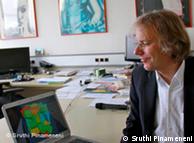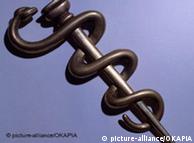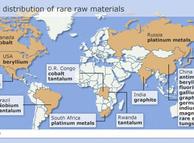Scientific findings may optimize magnets powering hybrid cars
As rare earths become more expensive and harder to mine, research teams
are focusing their efforts on reducing the use of these metals that lie
at the core of many high-technology goods.
A team of
scientists in Austria showed that the use of dysprosium - a strategic
rare-earth metal widely used in the motors of hybrid cars and other
green technologies - can be optimized and perhaps eventually
eliminated. Thomas Schrefl, head of the lab, presented the findings to
the Minerals, Metals & Materials Society in March.
The findings are a
notch in green-tech manufacturers' efforts to minimize dependence on
certain rare earths, the supply of which is largely controlled by China.
Schrefl's group, one of several research initiatives spread across
continents, has arrived at its findings using a mix of the Schrödinger
equation, super computers and some unexpected algorithms.
The magnet at the heart of the hybrid
 Bildunterschrift: Großansicht des Bildes mit der Bildunterschrift: Schrefl's research could reduce the need for expensive rare earths Bildunterschrift: Großansicht des Bildes mit der Bildunterschrift: Schrefl's research could reduce the need for expensive rare earths
The group of elements
known as rare earths is at the core of many high tech goods, ranging
from mobile phones to military missiles. Dysprosium, the focus of
Schrefl's research, belongs to this group of metals. An ingredient in
the permanent magnet that powers the motors of electric cars or wind
turbines, it is especially vital to the clean-energy industry.
"Rare-earth magnets
are the only ones which offer such compact drives with such high
efficiency at the same time," said Manfred Schrödl, head of the
Institute of Power Systems and Energy Economics at the Technical
University Vienna. "So we combine the advantages to make the optimum
motor."
Walking by rows of
electric motors in the cavernous workshop, Schrödl pulled out a rotor
disc the size of a paperweight. Its surface was stippled with slender
rare-earth magnetic strips made of a neodymium-iron-boron alloy and some
dysprosium, which is added to preserve magnetic properties at high
temperatures.
As slight as this
magnet rotor seemed in relation to the rest of the engine, it was
surprisingly heavy; the motor of every hybrid car uses about two kilos
(4.4 pounds) of rare-earth magnetic materials, which adds up quickly
considering the hundreds of thousands of hybrid cars entering the market
every year. In a single wind-turbine motor, the amount of rare earths
can weigh tons.
A cure for the magnet medicine
To explain his findings on rare-earth magnets, Schrefl first offered a primer on the making of one.
 Bildunterschrift: Großansicht des Bildes mit der Bildunterschrift: Rare earths serve as medicine for magnets Bildunterschrift: Großansicht des Bildes mit der Bildunterschrift: Rare earths serve as medicine for magnets
Grains of the
neodymium-iron-boron alloy are pressed into a mold. Because this metal
compound is intrinsically magnetic, each of these particles is a tiny
magnet with two opposing poles. To get all the north poles at one end
and the south poles at the other, the molded grains are exposed to a
strong magnetic field - one powerful enough to flip the magnetic
particles into alignment - and voila, a magnet is made.
For reasons previously
unclear, however, the resulting rare-earth magnet is weaker than
expected. Dysprosium is added to perk up its strength.
"It is like medicine
for the magnet," Schrefl said. "But it doesn’t change the atom
arrangement, it just improves the magnetic properties."
The lab's goal is to
do away with "magnet medicine" by tweaking the actual atom arrangement.
But first, the scientists had to identify the culprit particles - not a
simple matter since they would need to see what was happening on a scale
of a few nanometers, a scale too tiny for the most powerful microscope.
To create a simulation
that would show the crystal structure on an atomic scale, the team took
a fundamental equation of quantum mechanics - the Schrödinger equation,
which shows the probability of finding an atom in a certain region of
space - and solved it with the help of super computers and algorithms
like those used in online image-compression.
The scientists
simplified the Schrödinger's equation so that its complexity grew
linearly instead of exponentially with the number of particles in the
system, Schrefl said.
"We basically compress
the equations, the way you compress an image before sending it out on
the Internet," he said. These algorithms allowed them to create
material simulations that had previously been too complex to compute.
Earlier this year,
while studying the simulations, Schrefl isolated misaligned atoms at the
crystal grain boundaries that were weakening the magnetic strength. It
is this shift in atom position, he said, that deteriorates the magnetic
properties and causes the need for dysprosium.
The hard-to-get metal
 Bildunterschrift: Großansicht des Bildes mit der Bildunterschrift: The difficulty of getting to rare earths gives them their name Bildunterschrift: Großansicht des Bildes mit der Bildunterschrift: The difficulty of getting to rare earths gives them their name
A bright silver metal
soft enough to cut with a knife, dysprosium derives its name from a
Greek word that means "hard to get." It seems that the French chemist
who isolated it back in 1886 had a moment of clairvoyance.
China, which controls
almost all of the global rare-earth supplies slashed its export quotas
as much as 40 percent in the last year, and analysts suspect the numbers
will continue to fall. In 2010, the United States Department of Energy
identified dysprosium as one of the most critical elements that is at
risk of supply disruption.
The price of rare earths has spiked in recent years, but the problem with dysprosium is not just its cost.
"In the south of
China, the reserves of iron-absorption clays containing dysprosium are
running down," said Judith Chegwidden of Roskill Information Services, a
UK-based metals and minerals consultancy. "They will be exhausted maybe
within 15 or 20 years."
Production of both
hybrids cars and wind turbines, on the other hand, is expected to grow
at a healthy clip amid calls for cleaner transportation and energy
sources.
An optimization worth the change
Anxious to find
alternatives, some manufacturers have funded research teams in Japan,
America and Europe, including the one led by Schrefl at the St. Pölten
University of Applied Sciences in Austria. His project is a somewhat
secretive one, funded by a Japanese car manufacturer that the scientists
are not allowed to name.
 Bildunterschrift: Bildunterschrift:
The team is now
testing heat treatments and additives that re-align these atoms, thereby
reducing the amount of dysprosium the magnet needs.
So will their new and improved magnets be fitted into hybrid-car hoods anytime soon?
"It's probably very soon I guess, but I can't tell you," Schrefl said, laughing.
The one thing we do
know is that in Japan, where Schrefl's sponsor is based, motors account
for about half the total domestic power consumption, according to the
country's National Institute of Science and Technology Policy. It is
estimated that a one percent improvement in the efficiency of electric
motors, perhaps with the use of optimized magnets, would save the power
equivalent to that produced by a 500MW thermal power station.
In a nation dealing with a stricken nuclear plant, those numbers could add up to mean something worth the change.
Author: Sruthi Pinnamaneni
Editor: Sean Sinico
http://www.dw-world.de/dw/article/0,,14969712,00.html
|